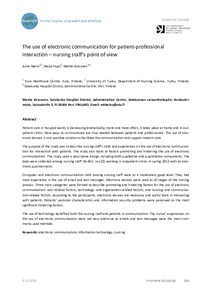The use of electronic communication for patient-professional interaction – nursing staff’s point of view
Niemi A; Hupli M; Koivunen M
https://urn.fi/URN:NBN:fi-fe2021042716225
Tiivistelmä
Patient care in hospital wards is decreasing dramatically; more and
more often, it takes place at home and in outpatient clinics. New ways
to communicate are thus needed between patients and professionals. The
use of electronic devices is one possible solution to facilitate the
communication and support modern care.
The purpose of the study
was to describe nursing staff’s skills and experiences on the use of
electronic communication for interaction with patients. The study also
looks at factors promoting and hindering the use of electronic
communication. The study used a descriptive design including both
qualitative and quantitative components. The data were collected among
nursing staff (N=567, n=123) working in outpatient clinics in spring
2012 with an electronic questionnaire.
Computer and electronic
communication skills among nursing staff were at a moderately good
level. They had most experience in the use of email and text messages.
Electronic devices were used at all stages of the nursing process. Three
main categories were formed to describe promoting and hindering factors
for the use of electronic communication: user-related factors;
technology- and organization-related factors; and nursing- and
communication-related factors. According to the participants, electronic
devices are necessary and useful tools in interacting with patients.
Patients’ personal characteristics and information security problems
were perceived as the most significant hindering factors.
The use
of technology benefited both the nursing staff and patients in
communication. The nurses’ experiences on the use of electronic
communication were not very extensive as emails and text messages were
the most commonly used methods.
Kokoelmat
- Rinnakkaistallenteet [27094]
